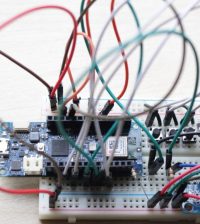- How to Adjust X and Y Axis Scale in Arduino Serial Plotter (No Extra Software Needed)Posted 2 months ago
- Elettronici Entusiasti: Inspiring Makers at Maker Faire Rome 2024Posted 2 months ago
- makeITcircular 2024 content launched – Part of Maker Faire Rome 2024Posted 4 months ago
- Application For Maker Faire Rome 2024: Deadline June 20thPosted 5 months ago
- Building a 3D Digital Clock with ArduinoPosted 10 months ago
- Creating a controller for Minecraft with realistic body movements using ArduinoPosted 11 months ago
- Snowflake with ArduinoPosted 11 months ago
- Holographic Christmas TreePosted 12 months ago
- Segstick: Build Your Own Self-Balancing Vehicle in Just 2 Days with ArduinoPosted 12 months ago
- ZSWatch: An Open-Source Smartwatch Project Based on the Zephyr Operating SystemPosted 1 year ago
FlyPi: 3D Printed, Low Cost and Open Source Lab Equipment

The pursuit of neuroscience can be costly, particularly when it comes to lab equipment.
Costs of commercially-available solutions can easily run into the tens or even hundreds of thousands; as a result, top-level research and training often gets confined to well-endowed institutes in rich countries.
But as shown in a recent study, many experiments can be performed using self-programmed electronics and self-assembled setups involving 3-D printed components.
FlyPi as a low-cost imaging and microscope system for research, training and teaching.
FlyPi’s design is based on a 3-D printed framework that holds a Raspberry Pi computer and camera, inexpensive LEDs for lighting and simple lenses. There are also optical and thermal control circuits based on open-source microcontroller Arduino.
The basic system costs less than 100€ (about $115), and offers low-cost modular options for research and assembly.
The developers share a keen interest in spreading “open labware” — the laboratory equivalent of open-source software where code is made available to others to use, change and share. The developers have taught courses in 3 D printing, programming and DIY lab equipment at universities in Kenya, Uganda, Ghana, Nigeria, South Africa, Sudan and Tanzania.
“Many institutions around the world have little money to spend on costly equipment,” says Baden, one of FlyPi’s developers. “We think it is very important that neuroscientific training and research open up to larger numbers of students and junior scientists. So we hope that, with open labware such as our FlyPi, we can offer a starting point.”















